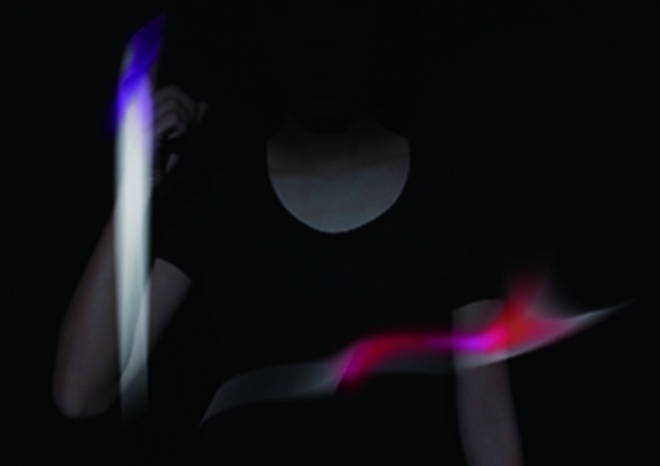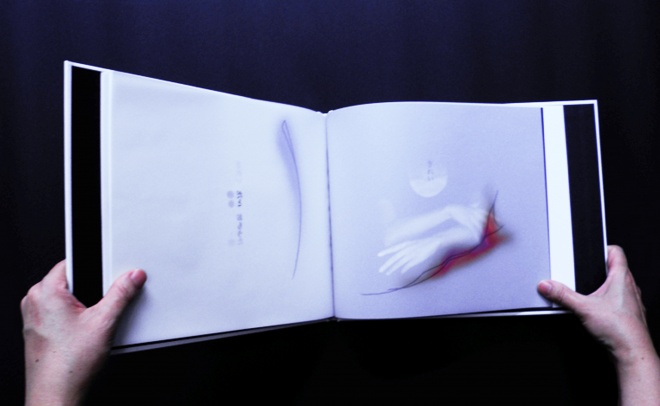- home>
- reports>
- news-report>
- Sign Language
| 2014.02.13 |
Sign Language
Sign Language
The 7th International Competition “NAGOYA DESIGN DO! 2010” Grand Prix
Design: Yuri Yoshida (Japan/In-house designer)
[Concept]
I wanted to use sign language to experience for myself the instant that language is born. Normally, we are unconscious of our use of words as a communication tool. In reality, each one of these words exists individually and each one is reciprocally connected in order to reach listeners. However, we are not conscious of this reality during everyday conversation. When using sign language, the instant that words are emitted can be seen in specific forms by the human eye, thus showing a portion of the true reality of communication. I have promoted this project so that we can feel an unusual portion of everyday, usual communication.
Sign language uses rough gestures instead of smooth sounds. When using such gestures, both the sender and receiver of words attempt to move closer together. This closeness caused me to feel hope in the roughness of sign language. I feel the essence of communication.
I will never forget the astonishment I felt when I first encountered sign language. Hands slipped through the air, and the incidents of sudden acceleration, like frames advancing in a movie, fascinated me. My surprise was at the existence of this kind of language. When I was thinking about my graduation project for Communication Design, it was this recollection that floated immediately to the forefront of my mind. Why was I so moved by sign language as a child?
For people like me who are not deaf, sign language makes us realize that the communication that we think of as completely ordinary is anything but. In the Japanese language, individual words are connected by particles. However, in everyday usage, the joints dissolve into individual words and the message becomes one single continuum. In sign language, the particles are expressed by the shape of the mouth, and, at least to me, a non-deaf person, give a clunky impression. That physical feeling, that sense of touch, immediately makes clear the obvious fact that conversation, or dialogue, is an aggregation of words.
Actually, this peculiarity is not confined to sign language.
It might be that with sign language, we are experiencing the moment when communication comes into being. Originally, language was born in the desire to express to another an as-yet-unclearly formed thought floating in the recesses of the mind. In the beginning, language was a rough-textured thing. Then, with the passage of many thousands of years, language was polished into beauty, and became smooth.
People think, “Did the same thing happen to me? Did the very act of transmitting my thoughts become fluent?”
Just because we speak fluently and smoothly doesn’t mean that we have fully communicated our thoughts. I have grown mature to the extent that I have come to understand this. People strive to express themselves because it is hard to express oneself. People strive to understand others because it is hard to understand others. I feel like it’s my experience of this rough texture that has allowed me to understand this.
It seems to me that in trying to return to the beginning of everything, I encountered my memories of sign language, and from there was able to attempt, once more and in earnest, to think about what communication really is.

(First appearance: IdcN Annual Report 2010/June, 2011)
*Judges’ comments can be found on the page at the Report: The 7th International Competition “NAGOYA DESIGN DO! 2010”.
Yuri Yoshida
- Report: Nagoya, UNESCO City of Design Promotion Projects FY 2013
- Report: creators shop Loop(Fourth and Fifth Session)
- Report: 2013 Nagoya City Emergency Job Creation Projects
Creative Industry Cooperative Promotion Projects - Report: Corporate Support・Design Planning and Production FY 2013
- Report: IdcN Design Promotion FY 2013
- Report|Design Tour: Fun with the Classics at Yokiso’s Choshokaku
- Electric Media: The Age of Radio
- Ziggurat Design 30s “American Art Deco and Skyscrapers”
- “LIFE” | America: Birth of Photojournalism Magazine
- American AD of 1930s | Lifestyle and Products
- Electric Dream: Household Electric Appliance and Modern Life
- Posters from the 30s: Modern Life and Graphic Design
















